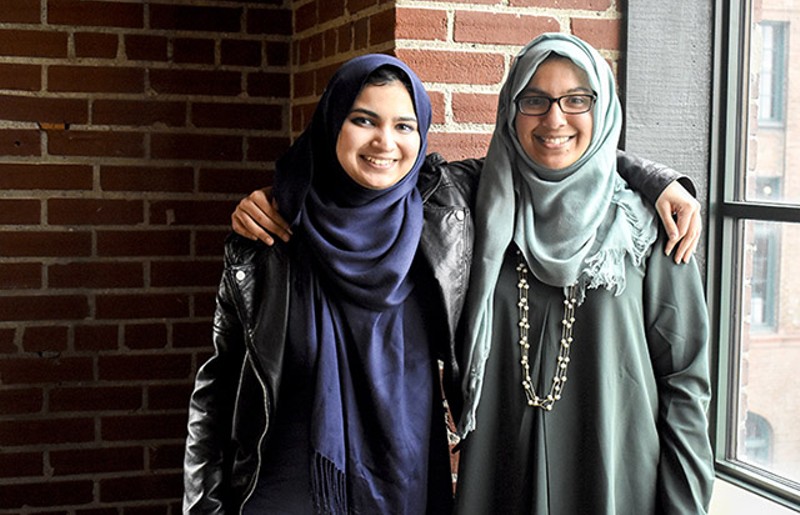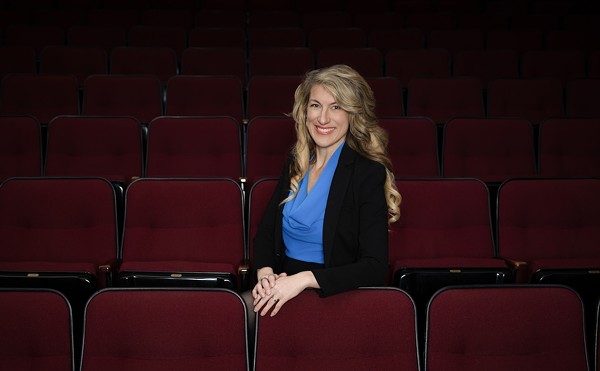
Yusra Ali has loved art since childhood. She began, as many little girls do, by drawing fairies with her friends. “Growing up, I thought art was something I had to keep to myself,” Ali says. “I was always shy, I never thought I’d make it to an exhibition. Would I be accepted?” Now, the 23-year-old is using art to empower her community by curating the second annual Muslim Art Exhibit Creativity and Identity, to be held at the Contemporary Art Museum (3750 Washington Blvd.) this Saturday.
Her earlier fears of acceptance may not have been unfounded; it's not easy to be a young Muslim in post-9/11 America. But Islam, Ali believes, does not dictate what flows from her mind through her hands and onto paper. Her art represents her individuality, not just her faith.
“America is my culture. This is where I live, this is where I grew up, this is all I know,” says Ali. And what she knows is what's reflected in her art. “My faith is just my motivation and inspiration for my life. However, my culture, whatever environment I’m living in, that’s also a part of me.”
Ali was inspired to create an exhibit for Muslim artists two years ago after she realized how underrepresented her community was in the art world. After partnering with the Council on American Islamic Relations, or CAIR, the event at Third Degree Glass Factory welcomed fifteen artists of all disciplines, as well as close to 300 patrons — a number no one expected.
And this year's show will be even bigger. For one thing, it's at a museum. For another, it will feature twice as many artists. And the vast majority of them — 28 out of 30 artists — are women.
The “exhibition on steroids,” as Ali’s younger sister Sadia has nicknamed it, is a one-day-only exhibition that will showcase everything from jewelry and fashion to painting and printmaking. For $15, attendees can enjoy food, music, poetry readings and, of course, visual art created by their Muslim neighbors.
The addition of a child-friendly area was a conscious choice made by the sisters to encourage mothers to participate, whether that is as patrons or artists. “This event gives them the opportunity to start getting bigger,” Ali says. “To start thinking that you aren’t just going to leave a culture for your kids, but for American culture itself. To become a part of American history.”
Getting women to apply wasn't easy.
“So many of the young girls that applied, applied late intentionally believing that they weren’t worth it,” says Sadia Ali, who is also the event coordinator for CAIR. “They didn’t see value in what they were doing.”
A word the sisters return to, time and time again, is security. In the country’s current climate, Muslim communities are constantly searching for it. That means frivolous things, like art, can be a weak point in their society, the sisters say. In order to achieve security, members must follow the system — go to school, get good grades, go to a good college, pursue medicine or engineering, anything that will provide them and their families security. Many Muslims feel that art is nothing more than a luxury.
But that is where the Ali sisters say Muslim women must step forward. “When other people see that you are comfortable in your shoes in the United States, you’re comfortable to create, you are melding your Muslim identity with the arts,” Sadia says with a pound of her fist against the table, “you can be a strong Muslim in the United States.”
Ninety percent of the artists in the show are local, but they have vastly different backgrounds. One of the few commonalities: strength.
Take Reem Taki of Michigan, who belongs not only to the Muslim community but to the community of over three million breast cancer survivors in the U.S. During her days in treatment, art was a welcome comfort.
Hamida Hashi is a Somalian refugee. Like so many other women across the country, her passion is fashion. Through her clothing line, Kismaayo Fashion, she has provided women who choose to wear traditional Islamic dress a more stylish option.
Kiki Salem is an artist who graduated from Hazelwood Central. The 22-year-old recently moved back to St. Louis after completing her Bachelor’s degree in fine art from the Art Institute of Chicago.
“Growing up post 9/11, there hasn’t been light shed on Muslim women, or Muslims in general,” she says. “The kind of visibility that an art show can give, shows the work that muslims can do and what muslim artists are about.” A Palestinian artist, Salem uses her talent to educate others about what is happening in the Middle East and what it means to be a Muslim in America.
Alia Rahman was a little girl who wanted to follow in her mother’s footsteps. After her mom introduced her to oil paintings, there was no going back. The flexibility of the oils captured her. Her other true love, though, is animals. The proceeds she made from last year’s exhibit went to benefit the World Wildlife Fund and she hopes to be able to donate even more this year to animals in need.
Other artists range from Elena Porcelli, a white convert to to Islam who makes jewelry, to Nefertiti, an African American convert and poet whom Yusra Ali vehemently calls a “survivor” and a “child prodigy.” Another artist, Adna Hodzik, is a Bosnian-American poet whose parents fled the war for a better life.
The first exhibit was about opening doors, and its success allowed the focus to shift from teaching outside communities to empowering the Muslim community. “Last year, people listened,” says Sadia Ali.
“Now, they’re seeing,” finishes her sister.
The exhibit is about showing that, in the Muslim community, the sum of parts does not always equal the whole. Yusra Ali finishes her thought. “Now you can’t look at a woman’s hijab and judge," she says. "Now you look at their work; you see directly into their heart as individuals.”





